What is TOD and why do we love it?

When it comes to incorporating sustainability into the built environment, it is important to acknowledge one key fact: we are living in a highly interconnected and globalized world. This is reflected in the way our cities are designed, as well as the movement of people within and between cities around the world.
This widespread travel within and between cities is able to occur due to the advent of modern transportation methods such as trains, busses, subways, automobiles, and planes. Unfortunately, one particular method of transportation has significantly influenced the design of our cities…and not in a good way!
Yep, you guessed it: the automobile. Automobiles are notorious for their contribution to urban sprawl, the uncontrolled expansion of urban areas.
Thanks to urban sprawl, it has become so much harder to get places on foot or take public transportation as your main method of getting around. For example, many North American cities have been designed specifically for automobiles, resulting in fewer sidewalks, larger distances between locations, and many low-density and single purpose areas which are not suitable for mass public transportation services.
This is a serious barrier to those living in urban areas who wish to reduce their environmental impact. Luckily, urban planners are aware of this issue and are looking for solutions!
One viable solution that promotes sustainable urban growth by reducing the use of private cars is Transit-Oriented Design, or TOD.
What is Transit-Oriented Design?
Transit-oriented design is a type of urban development which places importance on creating compact, walkable, mixed-use, and human-scale development which centres around high-quality transportation systems.

Basically, transit-oriented design makes developments desirable as places to live, work, and play without relying on private vehicles to get from place to place. And as we already know, a reduced reliance on vehicles leads to a reduced environmental impact, which in turn helps you achieve sustainable wellbeing! It feels good to do good! As a side benefit - it can also dramatically reduce your transportation bill if you don’t need to rely on a personal vehicle as your primary means of getting around to shop, work, and see others.
TODs aim to directly embed public and active transportation hubs into cities, making them into easily accessible and core elements of urban spaces. As a result, citizens are able to bus, walk, bike, or use any other form of active transportation to access these central transportation stations or stops which will allow people to access the rest of the city without personal vehicles.

Basically, TODs supply residents with a variety of modes of transit that have low financial and environmental costs.
Principles of TODs
Now that you are familiar with the general concept of TODs, here are some design principles which help to ensure TODs achieve their goals:
- The 10-minute walk. Since pedestrians and walkability are vital components of TOD, it is important that residential areas are located within a 10-minute walk (about 0.4 km or25 mile) of a centrally located transit station or transit corridor.
- Comfort and safety. Active transportation is facilitated through design features which increase comfort and safety such as trees which provide shade, bike paths, and adequate lighting at night.

- High densities. TODs should have the highest densities of residential and commercial buildings located within a five-minute walk from high-capacity transit stations.
- Connectivity. Smaller city blocks make it much easier for pedestrians and cyclists to get from point A to point B. In general, the longest dimension of city blocks should be no more than about 150m (or 164 yards). Large blocks can be reduced by creating pedestrian/cyclist paths that run through them.
- Attractive and functional design. If we want to attract people to TODs, they need to be aesthetically pleasing and offer plenty of amenities such as community spaces, plazas, activities, and services.

TODs in real life: The San Francisco Bay Area Rapid Transit District
While it’s all well and good to discuss the theory and aims behind TODs, we can also look at some real-life examples of TODs which are flourishing around the world! One well-known example of a TOD is the San Francisco Bay Area Rapid Transit District (BART).
This TOD was created in the 1990s as a result of community resistance to BART’s plan of building a parking garage between the BART station and the Latino neighbourhood’s commercial centre. Now the space between these two locations is filled with a pedestrian corridor, shops, offices, apartments, and plazas for the community to enjoy. It offers the community so much more than the parking lot ever would have - all because they listened to what the community knew they wanted and needed.
In alignment with the overall goal of TODs around the world, the Bay Area Rapid Transit District has successfully reduced the amount of people driving cars by promoting active transportation through design. For example, take a look at these statistics published in BART’s 2020 Transit-Oriented Development Program:
- People living near BART drive 13 to 32% fewer miles each year than the S. average.
- Residents living within this TOD take active and public transit for their daily needs 35 to 85% more often than those living further away.
- Typical transportation costs are 24% lower for households near BART versus the regional average.

As you can see, when applied in real life situations, TOD principles have the ability to create urban areas which are healthy, safe, and enjoyable for all! Can you consider integrating walking or other forms of active transportation into your daily routine? Or perhaps you can advocate for more transit-oriented design in your community, or vote for infrastructure like dedicated cycling lanes and sidewalks.
Stay connected with news and updates!
Join my mailing list to receive the latest news and updates. Your information will not be shared.

